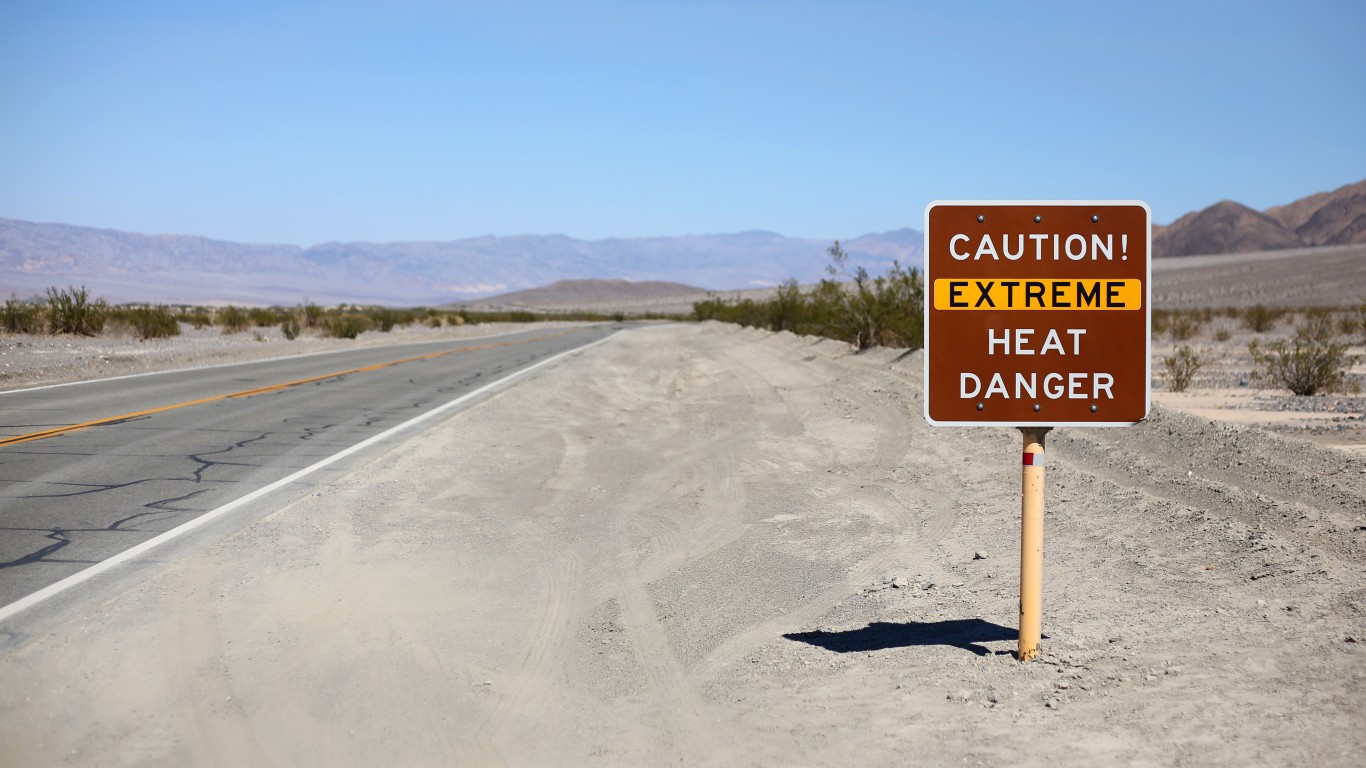
The summer of 2022 was one marked by destructive climate anomalies. Record-breaking heat waves in China, Europe, the U.K., and the U.S. jeopardized power grids, shut down transportation infrastructure, and fueled wildfires. Severe flooding led to thousands of deaths in Pakistan and mass evacuations in parts of the United States. Droughts in East Africa, Europe, and the Western U.S. depleted reservoirs and rendered key shipping routes impassable.
Weather events such as these are becoming increasingly common, and many have been linked to human-caused climate change, adding urgency to the global effort to reduce our environmental impact. (Here is a look at the worst climate-related disasters since 2010.)
In the U.S., reducing carbon emissions, preserving natural resources, and developing a clean and sustainable energy grid are key policy goals. And some states are doing more to meet these challenges than others.
24/7 Wall St. created an index of five measures: per capita carbon emissions, five-year change in total carbon emissions, energy consumption, renewable energy production, and recycling rates – or the share of recycled goods that end up in new products – to identify the states doing the most to fight climate change.
The states that rank most favorably on this list are concentrated in the Northeast and along the West Coast. Many of these states have implemented regulations that either incentivize or mandate more environmentally friendly behavior, both from industry and individuals.
In Massachusetts, for example, utility companies are required to derive a certain percentage of their electricity sales from clean energy sources – a percentage that increases by 2% annually and will hit 80% by 2050. Similarly, California Gov. Gavin Newsom recently announced an executive order mandating that all new passenger vehicles sold in the state must be zero-emission by 2035. (Here is a look at the states producing the most electricity from renewable sources.)
Meanwhile, many of the states that rank among the worst on this list are economically dependent on fossil fuel extraction and production. These states are located across the Midwest, South, and West, and include Wyoming, which accounts for about 40% of U.S. coal production, and Texas, a state that produces over 40% of all domestic petroleum.
Click here to see the worst states driving the climate crisis.
Click here to read our detailed methodology.

50. Maine
> Annual per capita carbon emissions: 10.7 metric tons (10th lowest)
> 5-yr. change in total carbon emissions: -13.5% (the largest decline)
> Total annual per capita electricity consumption: 8.5 MWh (10th lowest)
> Electricity production: 76.7% from renewable sources (3rd highest)
> Recycling rate: 74% (the highest)
[in-text-ad]

49. Vermont
> Annual per capita carbon emissions: 9.6 metric tons (5th lowest)
> 5-yr. change in total carbon emissions: -1.7% (30th largest decline)
> Total annual per capita electricity consumption: 8.5 MWh (11th lowest)
> Electricity production: 99.9% from renewable sources (the highest)
> Recycling rate: 62% (4th highest)

48. New York
> Annual per capita carbon emissions: 8.7 metric tons (the lowest)
> 5-yr. change in total carbon emissions: -3.1% (24th largest decline)
> Total annual per capita electricity consumption: 7.2 MWh (4th lowest)
> Electricity production: 28.5% from renewable sources (18th highest)
> Recycling rate: 58% (10th highest)

47. California
> Annual per capita carbon emissions: 9.1 metric tons (2nd lowest)
> 5-yr. change in total carbon emissions: +1.9% (12th largest increase)
> Total annual per capita electricity consumption: 6.4 MWh (2nd lowest)
> Electricity production: 42.6% from renewable sources (10th highest)
> Recycling rate: 54% (13th highest)
[in-text-ad-2]

46. New Hampshire
> Annual per capita carbon emissions: 10.2 metric tons (8th lowest)
> 5-yr. change in total carbon emissions: -8.8% (5th largest decline)
> Total annual per capita electricity consumption: 7.9 MWh (7th lowest)
> Electricity production: 16.0% from renewable sources (24th highest)
> Recycling rate: 44% (18th highest)

45. Massachusetts
> Annual per capita carbon emissions: 9.2 metric tons (3rd lowest)
> 5-yr. change in total carbon emissions: -5.1% (18th largest decline)
> Total annual per capita electricity consumption: 7.3 MWh (5th lowest)
> Electricity production: 8.6% from renewable sources (15th lowest)
> Recycling rate: 52% (14th highest)
[in-text-ad]

44. Rhode Island
> Annual per capita carbon emissions: 9.8 metric tons (6th lowest)
> 5-yr. change in total carbon emissions: -4.1% (20th largest decline)
> Total annual per capita electricity consumption: 6.9 MWh (3rd lowest)
> Electricity production: 6.9% from renewable sources (9th lowest)
> Recycling rate: 56% (12th highest)

43. Oregon
> Annual per capita carbon emissions: 9.9 metric tons (7th lowest)
> 5-yr. change in total carbon emissions: +10.4% (4th largest increase)
> Total annual per capita electricity consumption: 12.2 MWh (25th highest)
> Electricity production: 67.5% from renewable sources (6th highest)
> Recycling rate: 66% (2nd highest)

42. Maryland
> Annual per capita carbon emissions: 9.4 metric tons (4th lowest)
> 5-yr. change in total carbon emissions: -8.7% (6th largest decline)
> Total annual per capita electricity consumption: 9.5 MWh (12th lowest)
> Electricity production: 8.6% from renewable sources (14th lowest)
> Recycling rate: 41% (22nd highest)
[in-text-ad-2]

41. New Jersey
> Annual per capita carbon emissions: 11.3 metric tons (14th lowest)
> 5-yr. change in total carbon emissions: -2.7% (25th largest decline)
> Total annual per capita electricity consumption: 8.1 MWh (9th lowest)
> Electricity production: 3.4% from renewable sources (4th lowest)
> Recycling rate: 62% (4th highest)

40. Washington
> Annual per capita carbon emissions: 11.1 metric tons (12th lowest)
> 5-yr. change in total carbon emissions: +12.0% (2nd largest increase)
> Total annual per capita electricity consumption: 11.5 MWh (22nd lowest)
> Electricity production: 75.0% from renewable sources (5th highest)
> Recycling rate: 58% (10th highest)
[in-text-ad]

39. Iowa
> Annual per capita carbon emissions: 24.5 metric tons (10th highest)
> 5-yr. change in total carbon emissions: -0.2% (36th largest decline)
> Total annual per capita electricity consumption: 16.1 MWh (8th highest)
> Electricity production: 59.4% from renewable sources (7th highest)
> Recycling rate: 62% (4th highest)

38. Kansas
> Annual per capita carbon emissions: 20.8 metric tons (17th highest)
> 5-yr. change in total carbon emissions: -6.3% (13th largest decline)
> Total annual per capita electricity consumption: 13.6 MWh (20th highest)
> Electricity production: 44.2% from renewable sources (9th highest)
> Recycling rate: 37% (25th lowest)

37. Pennsylvania
> Annual per capita carbon emissions: 17.1 metric tons (21st highest)
> 5-yr. change in total carbon emissions: -6.1% (15th largest decline)
> Total annual per capita electricity consumption: 10.9 MWh (17th lowest)
> Electricity production: 3.7% from renewable sources (5th lowest)
> Recycling rate: 60% (7th highest)
[in-text-ad-2]

36. Connecticut
> Annual per capita carbon emissions: 10.3 metric tons (9th lowest)
> 5-yr. change in total carbon emissions: +0.8% (13th largest increase)
> Total annual per capita electricity consumption: 7.6 MWh (6th lowest)
> Electricity production: 3.2% from renewable sources (2nd lowest)
> Recycling rate: 63% (3rd highest)

35. Oklahoma
> Annual per capita carbon emissions: 22.9 metric tons (13th highest)
> 5-yr. change in total carbon emissions: -9.4% (4th largest decline)
> Total annual per capita electricity consumption: 15.8 MWh (9th highest)
> Electricity production: 39.7% from renewable sources (11th highest)
> Recycling rate: 29% (10th lowest)
[in-text-ad]

34. Minnesota
> Annual per capita carbon emissions: 16.3 metric tons (23rd highest)
> 5-yr. change in total carbon emissions: +3.1% (10th largest increase)
> Total annual per capita electricity consumption: 11.4 MWh (20th lowest)
> Electricity production: 27.6% from renewable sources (19th highest)
> Recycling rate: 60% (7th highest)

33. Illinois
> Annual per capita carbon emissions: 16.1 metric tons (25th highest)
> 5-yr. change in total carbon emissions: -7.2% (8th largest decline)
> Total annual per capita electricity consumption: 10.4 MWh (16th lowest)
> Electricity production: 9.7% from renewable sources (17th lowest)
> Recycling rate: 33% (17th lowest)

32. Hawaii
> Annual per capita carbon emissions: 14.5 metric tons (23rd lowest)
> 5-yr. change in total carbon emissions: +3.7% (9th largest increase)
> Total annual per capita electricity consumption: 6.2 MWh (the lowest)
> Electricity production: 15.9% from renewable sources (25th highest)
> Recycling rate: 45% (17th highest)
[in-text-ad-2]

31. Delaware
> Annual per capita carbon emissions: 13.9 metric tons (22nd lowest)
> 5-yr. change in total carbon emissions: -2.3% (27th largest decline)
> Total annual per capita electricity consumption: 11.5 MWh (21st lowest)
> Electricity production: 2.5% from renewable sources ()
> Recycling rate: 59% (9th highest)

30. Montana
> Annual per capita carbon emissions: 30.2 metric tons (6th highest)
> 5-yr. change in total carbon emissions: -0.8% (34th largest decline)
> Total annual per capita electricity consumption: 13.7 MWh (19th highest)
> Electricity production: 59.4% from renewable sources (8th highest)
> Recycling rate: 33% (17th lowest)
[in-text-ad]

29. Colorado
> Annual per capita carbon emissions: 15.9 metric tons (25th lowest)
> 5-yr. change in total carbon emissions: +0.5% (14th largest increase)
> Total annual per capita electricity consumption: 9.9 MWh (14th lowest)
> Electricity production: 30.9% from renewable sources (15th highest)
> Recycling rate: 33% (17th lowest)

28. Michigan
> Annual per capita carbon emissions: 15.9 metric tons (25th lowest)
> 5-yr. change in total carbon emissions: -3.2% (23rd largest decline)
> Total annual per capita electricity consumption: 9.7 MWh (13th lowest)
> Electricity production: 10.0% from renewable sources (19th lowest)
> Recycling rate: 40% (23rd highest)

27. Georgia
> Annual per capita carbon emissions: 12.8 metric tons (18th lowest)
> 5-yr. change in total carbon emissions: -6.3% (12th largest decline)
> Total annual per capita electricity consumption: 12.7 MWh (21st highest)
> Electricity production: 11.9% from renewable sources (21st lowest)
> Recycling rate: 36% (23rd lowest)
[in-text-ad-2]

26. Missouri
> Annual per capita carbon emissions: 19.1 metric tons (19th highest)
> 5-yr. change in total carbon emissions: -6.2% (14th largest decline)
> Total annual per capita electricity consumption: 12.4 MWh (24th highest)
> Electricity production: 7.5% from renewable sources (10th lowest)
> Recycling rate: 46% (15th highest)

25. Wisconsin
> Annual per capita carbon emissions: 16.3 metric tons (23rd highest)
> 5-yr. change in total carbon emissions: -5.0% (19th largest decline)
> Total annual per capita electricity consumption: 11.6 MWh (23rd lowest)
> Electricity production: 9.4% from renewable sources (16th lowest)
> Recycling rate: 40% (23rd highest)
[in-text-ad]

24. North Carolina
> Annual per capita carbon emissions: 11.7 metric tons (15th lowest)
> 5-yr. change in total carbon emissions: -1.7% (29th largest decline)
> Total annual per capita electricity consumption: 12.6 MWh (23rd highest)
> Electricity production: 15.5% from renewable sources (25th lowest)
> Recycling rate: 44% (18th highest)

23. Idaho
> Annual per capita carbon emissions: 11.2 metric tons (13th lowest)
> 5-yr. change in total carbon emissions: +11.4% (3rd largest increase)
> Total annual per capita electricity consumption: 13.9 MWh (17th highest)
> Electricity production: 76.1% from renewable sources (4th highest)
> Recycling rate: 36% (23rd lowest)

22. Utah
> Annual per capita carbon emissions: 19.2 metric tons (18th highest)
> 5-yr. change in total carbon emissions: -3.3% (22nd largest decline)
> Total annual per capita electricity consumption: 10.0 MWh (15th lowest)
> Electricity production: 12.5% from renewable sources (24th lowest)
> Recycling rate: 37% (25th lowest)
[in-text-ad-2]

21. Arizona
> Annual per capita carbon emissions: 12.7 metric tons (17th lowest)
> 5-yr. change in total carbon emissions: -2.6% (26th largest decline)
> Total annual per capita electricity consumption: 11.4 MWh (18th lowest)
> Electricity production: 12.0% from renewable sources (22nd lowest)
> Recycling rate: 36% (23rd lowest)

20. New Mexico
> Annual per capita carbon emissions: 23.3 metric tons (12th highest)
> 5-yr. change in total carbon emissions: -3.5% (21st largest decline)
> Total annual per capita electricity consumption: 11.8 MWh (24th lowest)
> Electricity production: 27.2% from renewable sources (20th highest)
> Recycling rate: 27% (8th lowest)
[in-text-ad]

19. Florida
> Annual per capita carbon emissions: 10.9 metric tons (11th lowest)
> 5-yr. change in total carbon emissions: -1.6% (31st largest decline)
> Total annual per capita electricity consumption: 11.4 MWh (19th lowest)
> Electricity production: 4.3% from renewable sources (6th lowest)
> Recycling rate: 42% (20th highest)

18. Tennessee
> Annual per capita carbon emissions: 13.5 metric tons (21st lowest)
> 5-yr. change in total carbon emissions: -6.6% (11th largest decline)
> Total annual per capita electricity consumption: 14.0 MWh (16th highest)
> Electricity production: 18.1% from renewable sources (22nd highest)
> Recycling rate: 22% (4th lowest)

17. South Dakota
> Annual per capita carbon emissions: 18.0 metric tons (20th highest)
> 5-yr. change in total carbon emissions: +13.0% (the highest increase)
> Total annual per capita electricity consumption: 14.4 MWh (15th highest)
> Electricity production: 80.5% from renewable sources (2nd highest)
> Recycling rate: 36% (23rd lowest)
[in-text-ad-2]

16. Ohio
> Annual per capita carbon emissions: 16.8 metric tons (22nd highest)
> 5-yr. change in total carbon emissions: -6.9% (10th largest decline)
> Total annual per capita electricity consumption: 12.2 MWh (25th lowest)
> Electricity production: 2.9% from renewable sources (the lowest)
> Recycling rate: 27% (8th lowest)

15. South Carolina
> Annual per capita carbon emissions: 13.5 metric tons (21st lowest)
> 5-yr. change in total carbon emissions: -5.4% (17th largest decline)
> Total annual per capita electricity consumption: 15.1 MWh (12th highest)
> Electricity production: 7.8% from renewable sources (11th lowest)
> Recycling rate: 34% (19th lowest)
[in-text-ad]

14. Kentucky
> Annual per capita carbon emissions: 25.8 metric tons (9th highest)
> 5-yr. change in total carbon emissions: -12.2% (2nd largest decline)
> Total annual per capita electricity consumption: 16.1 MWh (7th highest)
> Electricity production: 8.5% from renewable sources (13th lowest)
> Recycling rate: 24% (5th lowest)

13. Nebraska
> Annual per capita carbon emissions: 26.1 metric tons (8th highest)
> 5-yr. change in total carbon emissions: -0.5% (35th largest decline)
> Total annual per capita electricity consumption: 16.2 MWh (6th highest)
> Electricity production: 28.9% from renewable sources (16th highest)
> Recycling rate: 46% (15th highest)

12. Virginia
> Annual per capita carbon emissions: 12.5 metric tons (16th lowest)
> 5-yr. change in total carbon emissions: -0.8% (33rd largest decline)
> Total annual per capita electricity consumption: 13.8 MWh (18th highest)
> Electricity production: 6.6% from renewable sources (8th lowest)
> Recycling rate: 42% (20th highest)
[in-text-ad-2]

11. Alabama
> Annual per capita carbon emissions: 21.6 metric tons (14th highest)
> 5-yr. change in total carbon emissions: -10.9% (3rd largest decline)
> Total annual per capita electricity consumption: 17.0 MWh (5th highest)
> Electricity production: 12.4% from renewable sources (23rd lowest)
> Recycling rate: 22% (4th lowest)

10. Indiana
> Annual per capita carbon emissions: 26.2 metric tons (7th highest)
> 5-yr. change in total carbon emissions: -5.9% (16th largest decline)
> Total annual per capita electricity consumption: 14.5 MWh (14th highest)
> Electricity production: 8.2% from renewable sources (12th lowest)
> Recycling rate: 34% (19th lowest)
[in-text-ad]

9. Alaska
> Annual per capita carbon emissions: 46.7 metric tons (4th highest)
> 5-yr. change in total carbon emissions: -2.2% (28th largest decline)
> Total annual per capita electricity consumption: 8.0 MWh (8th lowest)
> Electricity production: 31.0% from renewable sources (14th highest)
> Recycling rate: 16% (the lowest)

8. Nevada
> Annual per capita carbon emissions: 13.5 metric tons (21st lowest)
> 5-yr. change in total carbon emissions: +8.4% (6th largest increase)
> Total annual per capita electricity consumption: 12.6 MWh (22nd highest)
> Electricity production: 28.8% from renewable sources (17th highest)
> Recycling rate: 39% (25th highest)

7. Texas
> Annual per capita carbon emissions: 23.6 metric tons (11th highest)
> 5-yr. change in total carbon emissions: +4.3% (8th largest increase)
> Total annual per capita electricity consumption: 14.9 MWh (13th highest)
> Electricity production: 21.8% from renewable sources (21st highest)
> Recycling rate: 32% (12th lowest)
[in-text-ad-2]

6. West Virginia
> Annual per capita carbon emissions: 47.6 metric tons (3rd highest)
> 5-yr. change in total carbon emissions: -7.1% (9th largest decline)
> Total annual per capita electricity consumption: 17.7 MWh (4th highest)
> Electricity production: 6.2% from renewable sources (7th lowest)
> Recycling rate: 31% (11th lowest)

5. Mississippi
> Annual per capita carbon emissions: 21.0 metric tons (16th highest)
> 5-yr. change in total carbon emissions: +2.0% (11th largest increase)
> Total annual per capita electricity consumption: 15.6 MWh (10th highest)
> Electricity production: 10.0% from renewable sources (18th lowest)
> Recycling rate: 17% (2nd lowest)
[in-text-ad]

4. Arkansas
> Annual per capita carbon emissions: 21.5 metric tons (15th highest)
> 5-yr. change in total carbon emissions: +10.2% (5th largest increase)
> Total annual per capita electricity consumption: 15.2 MWh (11th highest)
> Electricity production: 10.5% from renewable sources (20th lowest)
> Recycling rate: 28% (9th lowest)

3. Louisiana
> Annual per capita carbon emissions: 41.8 metric tons (5th highest)
> 5-yr. change in total carbon emissions: +5.0% (7th largest increase)
> Total annual per capita electricity consumption: 19.1 MWh (3rd highest)
> Electricity production: 3.3% from renewable sources (3rd lowest)
> Recycling rate: 26% (6th lowest)

2. North Dakota
> Annual per capita carbon emissions: 74.8 metric tons (2nd highest)
> 5-yr. change in total carbon emissions: -1.3% (32nd largest decline)
> Total annual per capita electricity consumption: 28.7 MWh (the highest)
> Electricity production: 38.1% from renewable sources (12th highest)
> Recycling rate: 33% (17th lowest)
[in-text-ad-2]

1. Wyoming
> Annual per capita carbon emissions: 101.9 metric tons (the highest)
> 5-yr. change in total carbon emissions: -7.8% (7th largest decline)
> Total annual per capita electricity consumption: 26.4 MWh (2nd highest)
> Electricity production: 16.1% from renewable sources (23rd highest)
> Recycling rate: 33% (17th lowest)
Want to Retire Early? Start Here (Sponsor)
Want retirement to come a few years earlier than you’d planned? Or are you ready to retire now, but want an extra set of eyes on your finances?
Now you can speak with up to 3 financial experts in your area for FREE. By simply clicking here you can begin to match with financial professionals who can help you build your plan to retire early. And the best part? The first conversation with them is free.
Click here to match with up to 3 financial pros who would be excited to help you make financial decisions.
Have questions about retirement or personal finance? Email us at [email protected]!
By emailing your questions to 24/7 Wall St., you agree to have them published anonymously on a673b.bigscoots-temp.com.
By submitting your story, you understand and agree that we may use your story, or versions of it, in all media and platforms, including via third parties.
Thank you for reading! Have some feedback for us?
Contact the 24/7 Wall St. editorial team.
 24/7 Wall St.
24/7 Wall St. 24/7 Wall St.
24/7 Wall St. 24/7 Wall St.
24/7 Wall St.

